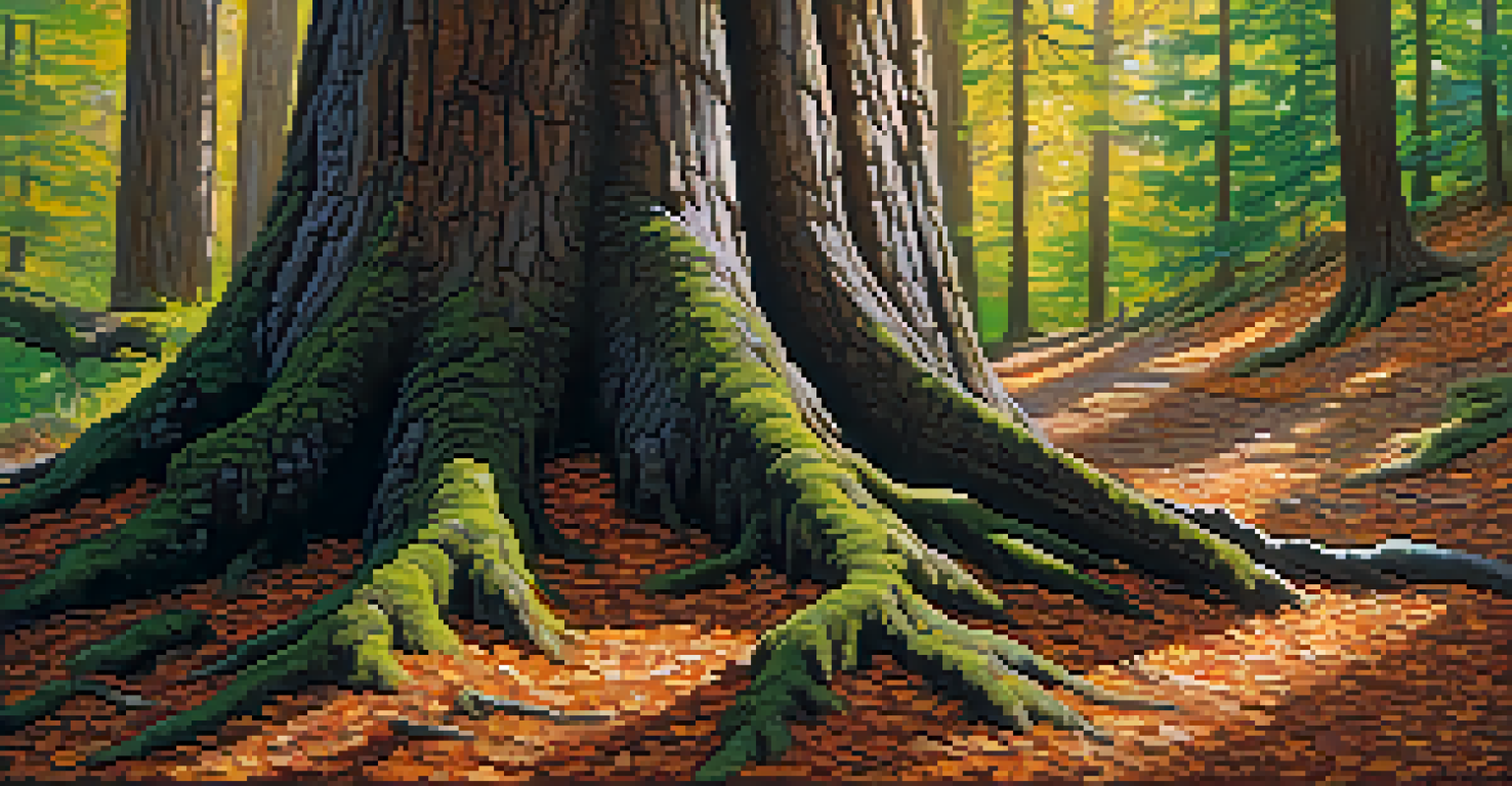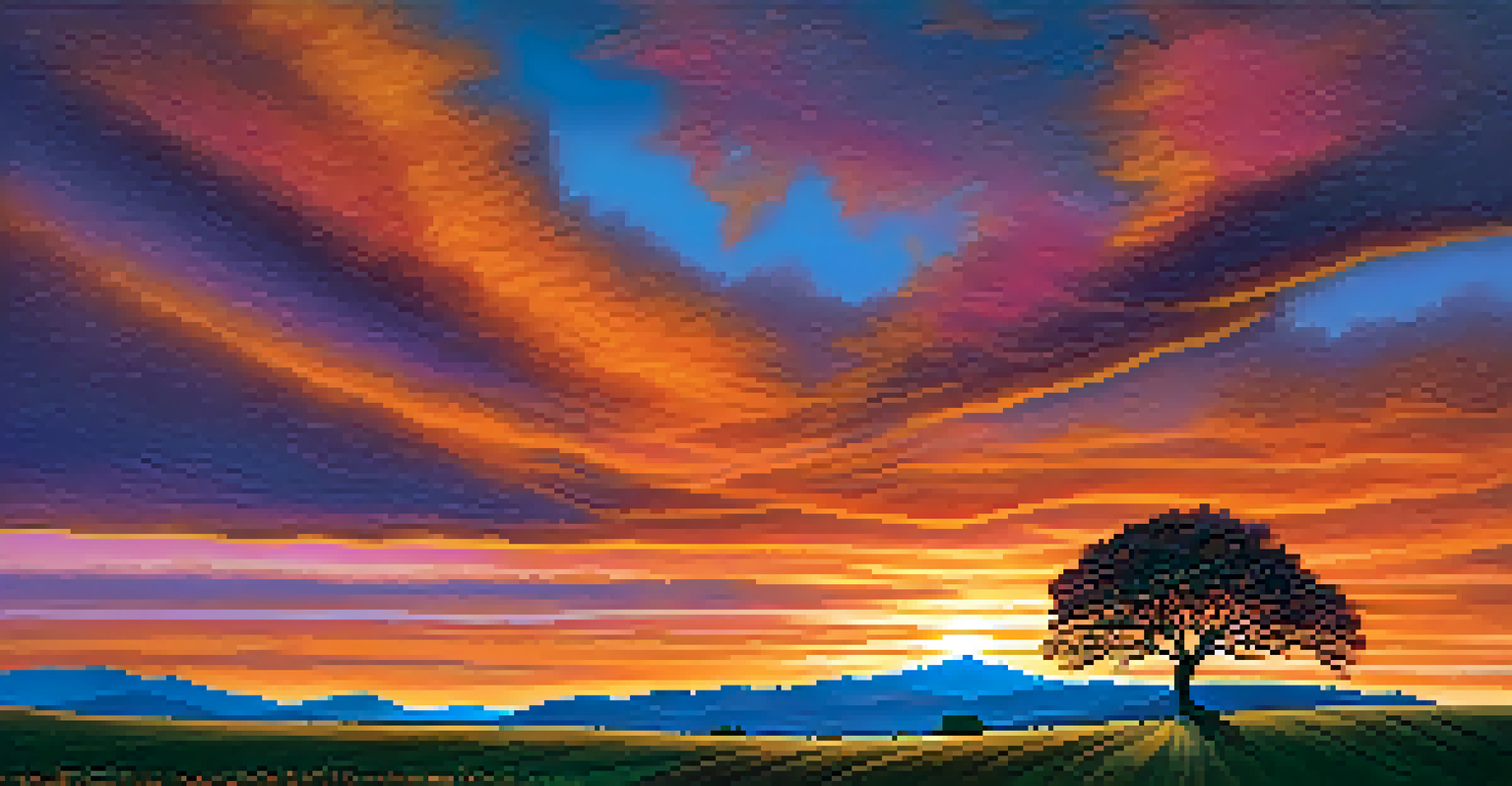Nature's Palette: How Landscapes Inspire Artistic Creations

The Connection Between Nature and Artistry
Nature has always been a muse for artists, providing a rich tapestry of colors, shapes, and forms. Whether it’s the vibrant hues of a sunset or the intricate patterns of leaves, landscapes evoke emotions that can transform into artistic expression. This connection runs deep, as many artists find that spending time in nature enhances their creativity and perspective.
Art is the most beautiful of all lies.
For example, famous painters like Claude Monet often ventured outdoors to capture the changing light and scenery directly. His series of water lilies and haystacks reflect not only the physical landscape but also the emotional response he felt while observing them. Such encounters with nature allow artists to translate their experiences into visual narratives that resonate with viewers.
Ultimately, the interplay between natural landscapes and artistic creation serves as a reminder of the beauty that surrounds us. Artists continually draw inspiration from their environments, creating works that invite us to see the world through their eyes. This connection is vital, as it not only enriches art but also deepens our appreciation for the natural world.
Colors of Nature: A Source of Inspiration
The colors found in nature are a powerful source of inspiration for artists. From the rich greens of a forest to the soft pastels of a sunrise, these hues can evoke a range of emotions and moods. Artists often use nature’s color palette to inform their work, selecting shades that reflect their intentions and feelings.

Consider how Vincent van Gogh used vibrant yellows and blues to convey the energy of a starry night. His iconic painting, 'Starry Night,' captures the essence of an evening sky, transforming it into a swirling vortex of color and light. This approach not only showcases the beauty of the landscape but also conveys the artist's emotional state.
Nature Inspires Artistic Expression
Artists draw profound inspiration from nature, using its colors, textures, and patterns to enhance their creativity and connect with viewers.
By tapping into nature’s colors, artists can create pieces that resonate on a deeper emotional level. This relationship with color helps to establish a dialogue between the artwork and the viewer, inviting them to explore their own feelings and interpretations of the natural world.
Textures and Patterns Found in Landscapes
The textures and patterns present in natural landscapes also play a significant role in artistic creation. From the rough bark of trees to the smooth surface of water, these elements add depth and dimension to artwork. Artists often mimic these textures to bring their pieces to life, allowing viewers to almost feel the landscape they are observing.
The artist's job is to be a witness to his time in history.
For instance, the way Georgia O’Keeffe portrayed the textures of desert landscapes in her paintings offers a tactile experience. Her bold, sweeping brushstrokes capture the essence of the arid terrain, inviting viewers to appreciate the beauty of simplicity and form. Through this representation, O’Keeffe connects the audience to the landscape in a visceral way.
By incorporating the textures of nature into their work, artists not only enhance visual interest but also create a sensory experience. This approach encourages viewers to engage with art on multiple levels, fostering a deeper understanding of both the artwork and the inspiration behind it.
The Role of Light in Natural Landscapes
Light is a crucial element in both nature and art, influencing how we perceive landscapes. The changing qualities of light throughout the day can dramatically alter the appearance of a scene, inspiring artists to capture these fleeting moments. Understanding light allows artists to create depth, mood, and atmosphere in their work.
Take, for example, the works of J.M.W. Turner, who was known for his masterful use of light. His paintings often showcase dramatic skies and the interplay of sunlight on water, evoking feelings of awe and wonder. By studying how light interacts with the environment, artists can create pieces that resonate with the viewer's emotions.
Cultural Identity in Landscapes
Landscapes reflect cultural identity, allowing artists to incorporate their heritage and values into their work, thus preserving important narratives.
Ultimately, the manipulation of light in art serves to bridge the gap between the viewer and the natural world. By capturing the essence of light in their work, artists invite us to experience the beauty of landscapes as they do, fostering a deeper connection to both art and nature.
Landscapes as Reflections of Cultural Identity
Landscapes often serve as reflections of cultural identity, revealing how different societies interact with their environment. Artists frequently draw inspiration from their surroundings, incorporating elements of their culture into their work. This relationship not only honors the beauty of the landscape but also emphasizes its importance within a cultural context.
For instance, traditional Japanese ink paintings often highlight serene landscapes that reflect the harmony between nature and humanity. These works exemplify the deep respect for nature found in Japanese culture, showcasing how landscapes can communicate values and beliefs. By capturing these scenes, artists preserve cultural narratives that might otherwise be forgotten.
Through the lens of cultural identity, artists create a dialogue between themselves, their environment, and their heritage. This connection enriches the artwork and provides insight into the ways landscapes shape our experiences and perceptions of the world around us.
Nature as a Catalyst for Emotion in Art
Nature has an inherent ability to evoke emotions, which artists often channel into their work. The beauty, chaos, and tranquility of landscapes can stir feelings of joy, nostalgia, or even melancholy. By tapping into these emotions, artists create pieces that resonate deeply with viewers, inviting them to explore their own feelings.
Consider the haunting landscapes depicted in the works of Caspar David Friedrich, whose paintings often evoke a sense of solitude and contemplation. His famous work, 'Wanderer above the Sea of Fog,' captures a moment of introspection against a dramatic backdrop. This emotional connection between the landscape and the viewer enhances the overall impact of the artwork.
Emotions Evoked by Natural Beauty
Nature serves as a powerful catalyst for emotion in art, enabling artists to create pieces that resonate deeply with viewers through shared feelings.
By using nature as a catalyst for emotion, artists create a powerful bond with their audience. This connection encourages viewers to reflect on their own experiences with the natural world, creating a shared understanding that transcends time and place.
The Future of Nature-Inspired Art
As the world continues to evolve, so too does the relationship between nature and art. Today, many artists are using innovative techniques and technologies to capture the essence of landscapes, blending traditional methods with modern practices. This evolution allows for new interpretations of nature that resonate with contemporary audiences.
For instance, digital artists are now able to create immersive landscapes that transport viewers to otherworldly environments. Virtual reality and augmented reality offer opportunities for audiences to experience art in ways that were previously unimaginable, fostering a deeper connection to the landscapes being portrayed. This shift opens up new avenues for artistic expression and exploration.

As we look to the future, the inspiration drawn from nature will undoubtedly continue to influence artistic creations. By embracing both traditional and modern approaches, artists can ensure that the beauty and complexity of landscapes remain an integral part of the artistic narrative, inspiring generations to come.